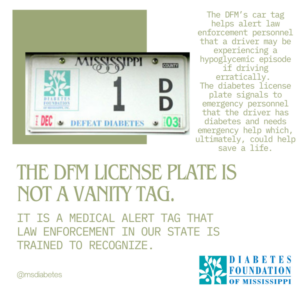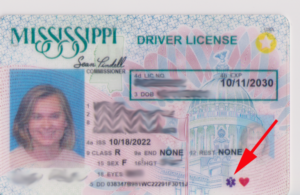The Diabetes Foundation of Mississippi is here to help make the transition from diagnosis of diabetes to part of daily life as smooth as possible. We are here to help educate schools, daycares, and work places to become more aware of the needs of those with diabetes. Through our advocacy, we have been able to help make the change to a new normal much easier.
Special License Plates and Drivers Licenses
 Help is here for Mississippians with diabetes!
Help is here for Mississippians with diabetes!
Thanks to a joint effort of the Mississippi Legislature, the State Tax Commission and the Diabetes Foundation of Mississippi, our license plate was launched in August of 2002 for people with diabetes. The DFM’s car tag helps alert law enforcement personnel when a driver may be experiencing a hypoglycemic episode and, consequently, driving erratically. The diabetes license plate signals to emergency personnel that the driver has diabetes, which, ultimately, could help save a life.
The license plate is available only to Mississippi drivers with diabetes. The plate has the DFM’s logo on it and says “Defeat Diabetes.”
There is no additional charge beyond your regular registration, taxes, and fees for the license plates if the car title is in the name of the driver who has diabetes. However, if the title is in someone else’s name, but the person with diabetes is the primary driver of the car, there is a charge of $38.00 for a diabetes license plate. Car tag prices may vary depending on the county.
 The Mississippi driver’s license for drivers with diabetes has a purple star on the bottom of the license, indicating that the driver has diabetes. There is also a space on the license to list whether the individual is insulin dependent or takes oral medications.
The Mississippi driver’s license for drivers with diabetes has a purple star on the bottom of the license, indicating that the driver has diabetes. There is also a space on the license to list whether the individual is insulin dependent or takes oral medications.
Forms:
Fillable Diabetes Tag Application to save to your computer
Download a copy of the Diabetes Tag and Driver’s License letter
Lifesaver Campaign for Law Enforcement
 The Diabetes Foundation of Mississippi provides a free in-service program to all law enforcement officials statewide. Law enforcement officials receive training on how to recognize diabetic emergencies and how to respond to the driver’s actions. In addition, law enforcement personnel are educated on hypoglycemia.
The Diabetes Foundation of Mississippi provides a free in-service program to all law enforcement officials statewide. Law enforcement officials receive training on how to recognize diabetic emergencies and how to respond to the driver’s actions. In addition, law enforcement personnel are educated on hypoglycemia.
The program also aims to inform the law enforcement personnel about medic-alert identification, diabetes license plates and special coded driver’s licenses, as well as different diabetes medications and supplies and the symptoms of hyperglycemic and hypoglycemic episodes.
Is it drinking, drugs, or diabetes? Low blood sugar (hypoglycemia) symptoms often mimic impairment caused by alcohol or drugs because the brain is not receiving the fuel it needs to operate properly. There are cases where individuals have been incarcerated for “drunk driving” when they should have been hospitalized.
To avoid a tragic error, check for:
- Diabetes car tag and/or driver’s license
- Medical alert card or bracelet
- Glucose tabs or gel
- Blood Glucose Meter
- Driver wearing Insulin Pump
Warning signs of low blood sugar:
- Dizziness
- Hunger
- Weakness or fatigue
- Blurred vision
- Shaking
- Uncooperative behaviors
- Rapid heartbeat
- Headache
- Irritability or anxiety
- Sweating
- Inability to waken
Give patients glucose gel and transport to nearest emergency room. Half a can of regular soda can be given if no gel is available and if patient is able to swallow.


 The Mississippi driver’s license for drivers with diabetes has a purple star on the bottom of the license, indicating that the driver has diabetes. There is also a space on the license to list whether the individual is insulin dependent or takes oral medications.
The Mississippi driver’s license for drivers with diabetes has a purple star on the bottom of the license, indicating that the driver has diabetes. There is also a space on the license to list whether the individual is insulin dependent or takes oral medications.